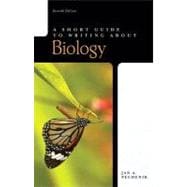This best-selling writing guide by a prominent biologist teaches students to think as biologists and to express ideas clearly and concisely through their writing.
Providing the reader with the tools needed to be successful writers in college and their profession, A Short Guide to Writing about Biology emphasizes writing as a way of examining, evaluating, and sharing ideas. The text teaches how to read critically, study, evaluate and report data, and how to communicate information clearly and logically.
Also given detailed advice on locating useful sources, interpreting the results of statistical tests, maintaining effective laboratory and field notebooks, writing effective research proposals and poster presentations, writing effective applications, and communicating information to both professional and general audiences.
Emphasizing writing as a means to examining, evaluating, sharing, and refining ideas, A Short Guide to Writing about Biology helps its readers get more out of their reading, lab work, education, and experience.
More than a "writing guide," this book teaches readers to think as biologists and to then express that thinking clearly and concisely through their writing and speaking. With comprehensive coverage on how to read and evaluate articles, how to interpret and describe the results of statistical tests, how to maintain laboratory and field notebooks, and how to communicate information concisely and convincingly to professional and general audiences, this book is a "must have" for anyone aspiring to a career in biology. This edition also provides considerable emphasis on the Internet and work with computers in Biology.
For anyone aspiring to a career in biology.








